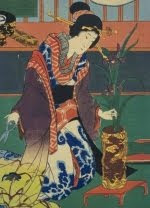Japanese bamboo baskets have a long history and have been used for many different purposes in everyday life. From the 16th century bamboo baskets have also been valued for their beauty as objects related to ikebana and the tea ceremony. There are two main styles in basket weaving. The rather stoic, finely woven Chinese influenced karamono style reflects the formalism of the Confucianism, and presents a perfect symmetry in form and a regularity in their woven technique. The more loosely woven wagumi style baskets on the other side, are simple and unpretentious with forms inspired by utilitarian and rustic objects. This Japanese style is more related to wabi-sabi esthetics.
Traditional wagumi bamboo basket.
New Zealand flax and Gerbera.
Freestyle, vertical arrangement.
My ikebana teacher challenged me to make an arrangement in a beautiful wagumi basket, asking what style of ikebana I thought would fit this rather bold basket design. I made a vertical style autumn arrangement using New Zealand flax, white Chrysanthemum and field flowers.
I thought the somewhat withered leaves and the humble flowers looked rather good in the basket. Still I had to agree that the much more simple ikebana design that my teacher suggested, with just a couple of leaves and one kind of flower, draw more attention to the basket itself. I was quite surprised by the result. The lesson learned: When arranging in a wagumi style basket all the focus should be on the unique shape of the basket. The flowers are there to complement and draw attention to the basket as an artwork.
Hanakago, flower baskets, were particularly popular in Japan in the late Meiji, Taisho and Showa periods, from around 1900 - 1950's. While Chinese influenced styles were the most popular in the late 1800's, the bold wagumi style flower basket epitomizes the free-wheeling styles prevelent at the turn of the century. Today good wagumi baskets are sold at quite high prices.
According to a website that I found, "wa (和) in wagumi means “peace” and “harmony”-the essence of the Japanese spirit-and hence stands as a symbol of Japan. Gumi (組) can be translated as “team,” and thus the name wagumi expresses collaboration founded on wa, the gentleness and warm-heartedness that can be found in nature, the land, human character, emotions, and other aspects of our world".
If you want to learn more about Japanese bamboo baskets I recommend these two illustrated articles:
Dana Micucci, Weawing Beauty: Japanese bamboo baskets hold their charm through the ages.
Jan Lee, Japanese Basket Art.
New Zealand flax and Gerbera.
Freestyle, vertical arrangement.
My ikebana teacher challenged me to make an arrangement in a beautiful wagumi basket, asking what style of ikebana I thought would fit this rather bold basket design. I made a vertical style autumn arrangement using New Zealand flax, white Chrysanthemum and field flowers.
I thought the somewhat withered leaves and the humble flowers looked rather good in the basket. Still I had to agree that the much more simple ikebana design that my teacher suggested, with just a couple of leaves and one kind of flower, draw more attention to the basket itself. I was quite surprised by the result. The lesson learned: When arranging in a wagumi style basket all the focus should be on the unique shape of the basket. The flowers are there to complement and draw attention to the basket as an artwork.
Autumn ikebana in bamboo basket.
New Zealand flax, Chrysanthemum, Tansy, Rumex longifolius.
Vertical arrangement.
New Zealand flax, Chrysanthemum, Tansy, Rumex longifolius.
Vertical arrangement.
Hanakago, flower baskets, were particularly popular in Japan in the late Meiji, Taisho and Showa periods, from around 1900 - 1950's. While Chinese influenced styles were the most popular in the late 1800's, the bold wagumi style flower basket epitomizes the free-wheeling styles prevelent at the turn of the century. Today good wagumi baskets are sold at quite high prices.
According to a website that I found, "wa (和) in wagumi means “peace” and “harmony”-the essence of the Japanese spirit-and hence stands as a symbol of Japan. Gumi (組) can be translated as “team,” and thus the name wagumi expresses collaboration founded on wa, the gentleness and warm-heartedness that can be found in nature, the land, human character, emotions, and other aspects of our world".
If you want to learn more about Japanese bamboo baskets I recommend these two illustrated articles:
Dana Micucci, Weawing Beauty: Japanese bamboo baskets hold their charm through the ages.
Jan Lee, Japanese Basket Art.














2 comments:
Thank you for explaining the way you arranged the flowers and changed it. Also I enjoyed the links of baskets that you posted very informative.
Thanks nadia for taking time to comment. It's so encouraging to hear that the information was useful.
Post a Comment